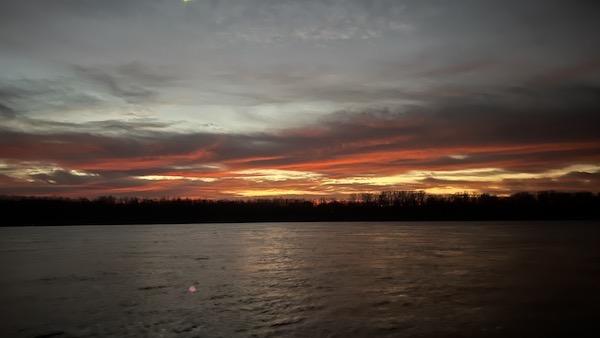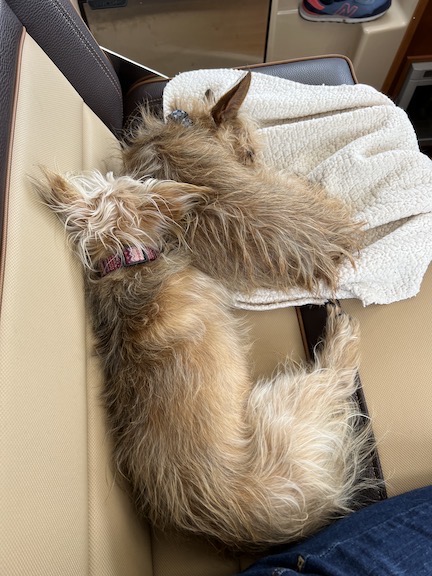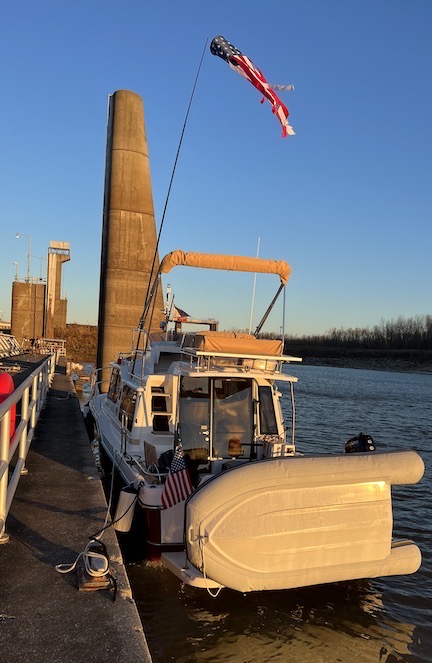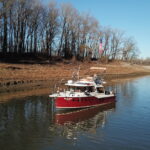November 29, 2022: We make the first leg of our long, fuel-less, marina-less stretch of the Great Loop and deal with late forecasted wind.
(continued from Alton, IL to Kimmswick, MO)
There were two parts of the Great Loop cruise that had me worried when I started my trip in October, and I was about to start the first of them: the 204-mile stretch from Hoppie’s Marine Service to the Paducah City Dock. It worried me for two reasons: first, I’d have to go 204 miles with no access to fuel, water, or pump out service. Second, we’d have to anchor out at least two nights and I had done absolutely nothing to resolve my windlass issues. (You’ll have to keep reading this blog to learn what other part of the trip worried me.)
And that’s what was on my mind as we prepared to leave Hoppie’s with a full fuel tank (145 gallons), about 3/4 tank of fresh water (30 gallons), and about 1/4 full waste tank (10 gallons). With luck, we could cover those miles in four days, ending up at Paducah City Dock to stay on the fourth night out. That was my goal, anyway.

At least Hoppie’s treated us to a great sunrise.
Cruising From Hoppie’s
Our first night stop would be at the Kaskaskia Lock Wall, which was literally a wall on the outside of a lock about a half mile up the Kaskaskia River. In my notes from Harbormaster Jeremy’s briefing in Ottawa, I’d marked it “Must Stop.” At the time, I was under the impression that there was something fascinating about this stop that made it a desirable destination. But as I researched the days ahead of me, I realized it was a “must stop” because there weren’t many good alternatives around.
I was looking forward to a nice secure wall as a place to tie up to. The weather was cold and overcast and the forecast called for high winds in the afternoon and evening. Anchoring out was not a good option with high winds, especially given my limited experience and Alyse’s lack of experience. The winds would calm down the next day so we’d be fine to continue from there to our next stop, which had to be an anchorage.
And this is where it got tricky. You see, although we only had to cover about 37 nautical miles before sunset that day, subsequent days would be a lot longer. It would be very tempting to just push the throttle forward and go to cover as much of the route as I could as quickly as I could. But I had to make that 145 gallons of fuel last 204 miles. That meant keeping my power level low to conserve fuel.

One way to keep my pups from getting into mischief while underway is to put them up on the seat beside me. They sleep all day so they’re ready to pester me when I’m trying to dock the boat.
With that in mind, after leaving Hoppie’s at about 8:30 AM, I set the throttle to about 2000 RPM. According to my engine computer and chart plotter, which talk to each other and do a lot of math, I was burning 3.9 gallons per hour but getting 2.5 nautical miles per gallon at 9.5 knots. I was expecting around 7 to 8 knots. Obviously, the mighty Mississippi was helping out with a good current in my favor. I’d take it!
So we chugged along, passing the occasional tow with plenty of room to get by. There was a strong headwind and choppy water, but the ride wasn’t uncomfortable. I had the helm heater going — that’s part of the engine cooling system and uses engine heat to heat the air it blows right at the helm — and we kept toasty warm inside. My pups slept on the seat beside me. Alyse and I chatted and she did stuff on her phone. We passed uncharted dredging operations. We lost cell service for a while.
And then we came around a bend in the river and the mouth of the Kaskaskia River was up ahead on the port side. There were some tows to talk to and I made the turn up the river.
At Kaskaskia Lock Wall
The water was much calmer there in the narrow river, even though the dam let some water flow into the channel. I slowed down, seeing the lock and dam ahead of me, and called the lockmaster on the radio. No answer. I called on the phone — fortunately, our cell signal had returned. Could we park along the wall for the night? Yes, he said. He instructed us to pull up to the forward section of the wall and it took me a while to figure out exactly where I had to go after I hung up. Soon I was pulling up beside the wall, fiddling with the fenders on the port side (which still weren’t set right to park against a wall), and tying us up with one of the midship lines.
And that’s when I realized the the cleats, which were huge, were so far apart that I’d need the two longest lines I had to get my boat secured between two of them.
But there was no wind, despite the forecast, and I found that tying the boat to one cleat between the two midship lines with those lines kept us secured nicely right against the wall.
I noticed that there was a tow in the lock next to us. That’s probably why the lockmaster hadn’t answered the radio — he was busy locking someone down.
There were signs all over the wall that warned against trespassing and tying up to the metal rail along the wall. There was nothing up there but concrete and those rails and pipes. There was no way to get to land. My pups would be very disappointed, especially if I couldn’t take them off the boat at all.
I called the lock again and asked permission to walk the dogs along the top of the lock. I promised to clean up after them. The person who answered said I could but told me they had to be leashed. As if there was someplace they could go.
It was early but we were there. We settled down for the afternoon. The barge that was in the lock came out and headed for the Mississippi. Another one came up from the Mississippi and pulled into the lock right next to us. It was fascinating to watch, even though our vantage point was below the lock gate and we couldn’t see what happened once the barge got into the lock and the gate closed. Still, we were very close to the incoming and outgoing barges.
After a while, we had dinner and settled down for the evening. I honestly don’t remember what we did, but I know I didn’t blog. I was having the same problems with Alyse on board as I had with Janet on board: I simply could not sit down to write with someone sitting across the table from me. (It would take a very long time for me to catch up; this blog post was written a month and a half after the events I’m blogging about.)
The Wind Arrives
Finally, after about 830, I put my pajamas on and got into bed to read with my pups. Within 10 minutes, the wind started blowing hard and the boat started pulling away from the lock wall. I knew that it wasn’t going to break loose, but I also knew that I didn’t want it bouncing around all night against the concrete. Yes, there are fenders in place to protect the boat, but the boat really does need to be secure.
So I got out of bed and climbed out onto the wall in my pajamas to see what I could do. The wind was really howling — it was as if someone had turned on a giant wind machine and it was blowing over the wall and onto the boat. The bow wanted to pull away from the wall and the stern and was hitting the wall. There was no way I could leave it like this overnight.
I called Alyse out for assistance. I wanted to move the boat up between two cleats and tie the bow to one and the stern to the other. I had the lines I needed to do this, but they were stowed; this is before I had organized all of my lines. I pulled out the longest lines I had and attached one to the bow cleat and the other to the stern cleat on the port side. Then, with me holding the bow line and Alyse holding the stern line, I untied the midship lines and we moved the boat forward about 20 feet so it was centered between two cleats. This was no easy task. Although the boat is normally pretty easy to move with lines, it does weigh more than 10,000 pounds and it had a good, strong wind blowing against it. (Keep in mind, that we were also doing it in the dark in our pajamas.) Eventually, though, we got it into position and tied it off the way I wanted to. Unfortunately, without any midship lines, the boat was still blowing away from the wall. It simply was not secure and I honestly did not think it was safe. So I did the one thing that dozens of signs along the wall clearly stated I was not allowed to do: I tied a midship line to the vertical post at the bottom of one of the rails.

Here’s what the boat looked like the next morning, after I’d removed that midship connection to the rail.
I do understand the problem with boats tying up to the rails. Although the rails were very sturdy and securely attached to the concrete wall with vertical posts about 8 or 10 feet apart, many of the boats that tie up at the wall are very large and could easily damage the rails in heavy wind conditions. My boat was relatively small, I reasoned, and I was tying up at the very bottom of the rail’s vertical post, in a place that was least likely to bend or move. And it wasn’t the only line holding the boat. But it turned out to be the vital one since it held the boat firmly against the wall. After securing it and sending Alyse back to bed, I tightened the bow and stern lines as well as I could. Then I ran a very long line from the aft midship cleat to the cleat where the port stern was already secured. I did the same with the starboard side bow cleat to the cleat where the bow was secured. With five lines securing the boat, it wasn’t going to blow away. With that nice, tight midship connection to the rail, it wasn’t even going to move much.
I slept poorly, worried that the lockmaster was going to come down and knock on the window and tell me to get the line off his rail. But that didn’t happen. In the morning, the wind had died down and I removed the line from the rail when I walked my pups atop the wall, thus removing evidence of my rule-breaking.
(continued in Modoc, IL to Cape Girardeau, MO)



Fascinating to read. Makes me feel as though it’s cold and windy here – in my cozy living room.
Trying to follow you on Nebo, but I think you and I have to be “friends” first.
That’s weird about Nebo. You should be able to just follow that link and it should show you where I am. If I’m underway, it should show you my progress on that cruise. I’m wondering if this has anything to do with the fact that Alyse set up Nebo on her phone with my boat name and it sometimes appears in California or Arizona. She might have set that to private and maybe that’s what you’re looking at? But if you click the link, it should just go to my account’s boat page. I’m just confused as you are about this.
Is anyone else reading this having the same problem?
Another nice Blog post. 1st – I’m having zero issues following on Nebo. 2nd, one thing I’ve seen sailing cruisers do when tying up in storms is to run the boat’s stern cleat line forward to the bow-end wall cleat, and then vice-versa. I’m NO authority on this, so take it for what it is – just an observation, but in my landlubber’s brain it makes sense
That’s a spring line — when you tie forward from the back and back from the front. I barely had enough line to reach the cleats from the closest point on the boat. I’ve since replaced all my short lines with long ones. My lines are a lot longer than they need to be, but it’s better to have them too long than not long enough.